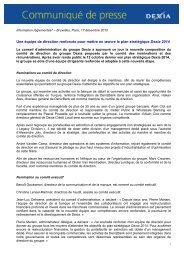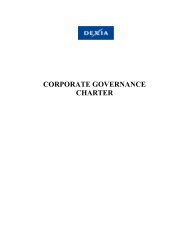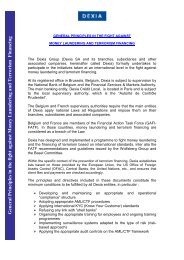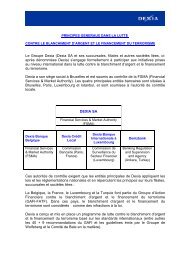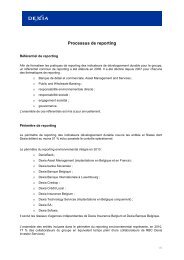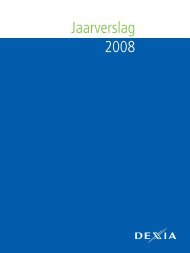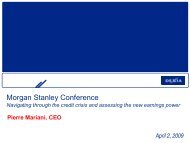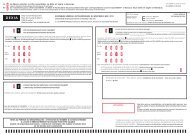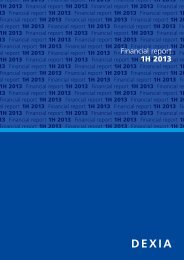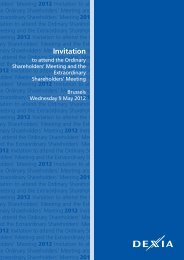Annual report 2010 - Dexia.com
Annual report 2010 - Dexia.com
Annual report 2010 - Dexia.com
- No tags were found...
You also want an ePaper? Increase the reach of your titles
YUMPU automatically turns print PDFs into web optimized ePapers that Google loves.
Risk managementManagement <strong>report</strong>Consolidatedfinancial statementsAdditional information <strong>Annual</strong> financial statementsMarket risk<strong>Dexia</strong> policyIn order to have an integrated and sound market riskmanagement, <strong>Dexia</strong> developed a framework based on thefollowing <strong>com</strong>ponents:• a <strong>com</strong>prehensive risk measurement approach, whichconstitutes an important part of the process of monitoringand controlling the Group’s risk profile;• a sound structure of limits and procedures that governrisk taking. The limit system must be consistent with theeffectiveness of the organisation’s overall risk measurementand management process and with the adequacy of thecapital position. These limits are integrated to the fullestextent possible;• a strong risk management organisation responsible foridentifying, measuring, monitoring, controlling and <strong>report</strong>ingrisk. The development of an enterprise-wide risk managementframework must be responsive to the nature of the challengesthe bank has to face. This approach provides the managementwith the assurance that risks are being managed in accordancewith <strong>Dexia</strong>’s strategy and objectives and with the overall riskappetite framework.Risk measuresThe <strong>Dexia</strong> Group adopted the VaR (Value at Risk) measurementmethodology as one of the leading risk indicators. The VaR isa measure of the potential loss that can be experienced witha 99% confidence level and for a holding period of 10 days.<strong>Dexia</strong> applies multiple VaR approaches based on their abilityto measure market risk accurately in different market activitiesand portfolios.• General interest-rate and forex risks are measured througha parametric VaR approach.• Specific interest-rate risk, equity risk and other risks intrading books are moreover measured by means of a historicalVaR approach.• Non-linear and particular risks are measured throughspecific and historical VaR methodologies with a view to amore appropriate measurement of the sensitivity to marketvolatilities.<strong>Dexia</strong> exposure to market risk as measured in Value at Risk(VaR) terms stems mainly from general interest-rate risk andspecific interest-rate (spread) risk reflecting today’s volatility incredit markets, while its market exposure arising from tradingpositions in equity, exchange and other risk factors remainsmuch lower.<strong>Dexia</strong> applies the internal VaR model for the regulatory capitalrequirement calculus on foreign exchange risk and generalinterest-rate risk within the trading scope.The VaR methodologies are improved on an on-going basis.The “Market Risk Engine” project was launched in <strong>2010</strong>.It aims for an historical VaR over all risk factors (with a<strong>com</strong>plete revaluation on non-linear risk factors); a <strong>com</strong>pletehistorical VaR which is confirmed as the standard in manybanks will provide a consistent and more precise measure.In addition to VaR, the new tool will facilitate stress testing,the analysis of extreme values and so on. The first phase ofthe project has already been successfully implemented andenabled existing historical VaR to be consolidated, historicalVaR to be added on the basis of sensitivities and progress tobe made on implementing the Stressed VaR as requested bythe regulator.In <strong>2010</strong> back-testing generated three exceptions for interestraterisk and foreign-exchange risk (internal model), threewithin the equity risk scope and none on spread scope, whichproves the quality of the tools used.As a <strong>com</strong>plement to VaR measures and statement of in<strong>com</strong>etriggers, <strong>Dexia</strong> applies a wide range of other risk measures inorder to assess risks related to the different business lines andportfolios (nominal limits, maturity limits, market limits andlimits on authorised products, sensitivity limits and Greeksand scenario analysis).Stress-testing is be<strong>com</strong>ing increasingly important for soundrisk management as it explores a range of low-probabilityevents outside the predictive capacity of VaR measurementtechniques. As such, VaR measures assess market risk in adaily market environment, whereas stress-testing measuresmarket risk in an abnormal market environment. In thiscontext, the range of scenario assumptions was regularlyrevised and updated. The results of consolidated stress testsand the corresponding analyses are presented quarterly to theMRGC and the DMRC.The bond portfolio on the banking books is not subject toVaR limits, given its different investment horizon. Followingthe <strong>Dexia</strong> transformation plan, this portfolio is largely inrun-off.Exposure to market risk (1)Value at RiskThe detailed VaR use of market activities (bond portfolio inbanking book not included) is disclosed in the table below.Average global Value at Risk amounted to EUR 44.6 million in<strong>2010</strong> (as <strong>com</strong>pared to EUR 78.4 million in 2009).Substantial limit reductions have been implemented, in linewith the risk appetite reduction as included in the overall<strong>Dexia</strong> transformation plan. The global limit has been reducedfrom EUR 178 million in the third quarter of 2008 to EUR 130million at the end of 2008 and to EUR 100 million since thebeginning of 2009.Bond portfolio<strong>Dexia</strong> (excluded BSM portfolio and Financial Products, seebelow) manages bond portfolios, largely in run-off, amountingto EUR 138.5 billion as at 31 December <strong>2010</strong> (againstEUR 165.5 billion as at 31 December 2009). The sensitivityin economic value of these bonds portfolios is very limited, asinterest-rate risk is hedged.An important part of the bond portfolios is classified inLoans & Receivables. The AFS reserve of these securities isinsensitive to the market spread evolutions. Regarding theother bonds portfolios classified in AFS, the sensitivity in fair(1) More information is given in the note 12.5. “Market risk & BSM” to theconsolidated financial statements (page 225).84 <strong>Dexia</strong> <strong>Annual</strong> <strong>report</strong> <strong>2010</strong>



